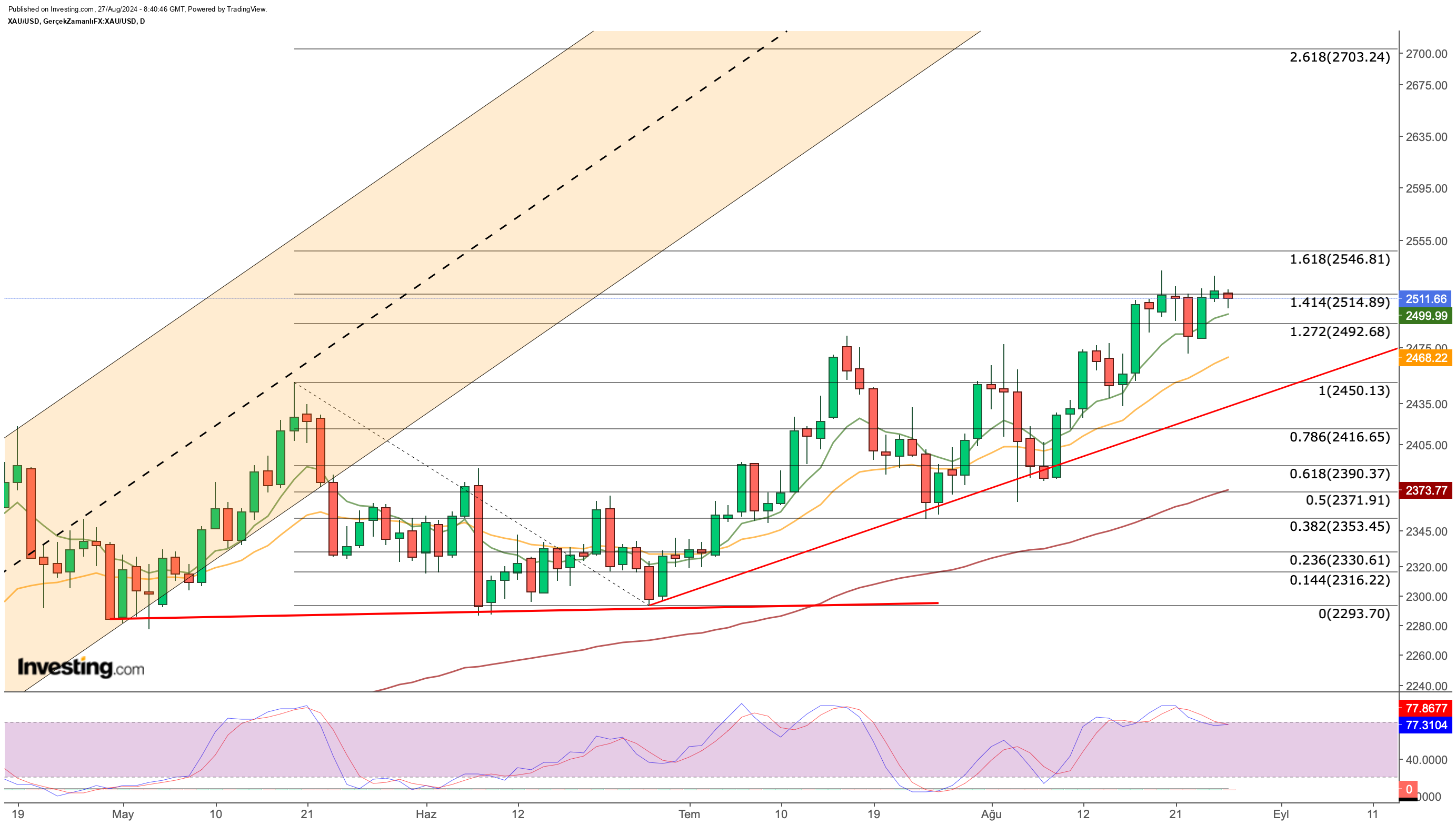- Gold has been consolidating gains after its recent surge to record highs.
- As of now, the bulls are looking for new catalysts to push the prices higher.
- The yellow metal needs a boost from 2 key tailwinds to sustain a move above $2,550.
- For less than $8 a month, InvestingPro's Fair Value tool helps you find which stocks to hold and which to dump at the click of a button.
Gold prices rallied last week, buoyed by a dovish speech from Federal Reserve Chair Jerome Powell. While the metal's upward momentum has shown signs of slowing, it remains on a positive trajectory.
Market participants are currently anticipating a 25-basis-point rate cut in September, which could pose a short-term obstacle for the yellow metal as bulls desire a bigger interest rate cut.
This is because a smaller cut could hamper the expected 100-basis-point reduction by year-end, potentially favoring dollar-based yields over non-interest-bearing gold.
However, two key economic indicators - U.S. GDP data on Thursday and the PCE inflation index on Friday - could significantly impact gold prices.
Despite these potential headwinds, several factors remain supportive of gold's long-term outlook. Below, we'll delve into 2 key catalysts that the yellow metal needs to keep the rally going.
1. Fed’s Rate Cut Impact
Upcoming data releases will significantly influence the Fed's decision on whether to cut rates by 25 or 50 basis points in September.
Alongside growth data and the Personal Consumption Expenditures Price Index (PCE), Thursday’s unemployment claims will be crucial.
Powell’s recent remarks highlighted the Fed’s readiness to lower rates if inflation moves closer to the 2% target and if labor market conditions weaken further.
A higher-than-expected jobless claims figure could prompt a 50 basis point cut, and PCE data meeting or falling below expectations might favor a dovish stance too.
Conversely, if the Fed opts for a smaller 25 basis point cut, gold could see a short-term decline in demand.
San Francisco Fed President Mary Daly and Richmond Fed President Tom Barkin have both supported a dovish policy stance, reinforcing Powell’s position.
Daly noted, "It’s time to adjust policy," while Barkin emphasized concerns about the labor market.
Recent price action in the dollar index, which fell to its psychological support at 100 but rebounded slightly, triggered profit-taking in gold.
While the Fed’s dovish stance continues to support gold, last week’s price movements suggest that this outlook is largely priced in, and gold may need an additional catalyst to sustain its rally.
2. Geopolitical Risks
Geopolitical tensions, particularly in the Middle East, could enhance gold’s appeal as a safe-haven asset.
A rise in geopolitical risks could drive gold prices sharply higher as investors seek refuge in the precious metal. Ongoing conflicts in the Middle East, if they escalate, could further boost gold’s demand.
In summary, while the Fed’s policy direction and geopolitical risks are key factors influencing gold, investors should watch for additional developments that could impact gold’s trajectory in the remainder of 2024.
Gold: Critical Price Levels to Monitor
Gold hit a new record high of $2,531 last week but faced resistance around $2,514, limiting further gains.
As the new week began, gold initially broke above the short-term resistance level but is now trending slightly lower.
This retreat comes amid partial stabilization in the dollar and bond yields. Investors are likely waiting for the upcoming U.S. growth and PCE data later this week to guide their positions.

Technically, if gold can close a daily candle above the $2,514 resistance this week, it would reinforce the bullish trend and potentially push the price toward $2,550.
This positive outlook could gain further momentum if the data supports a 50 basis point Fed rate cut in September.
Conversely, if gold struggles to surpass its current resistance, increased selling pressure could drive the price down to around $2,490.
A failure to hold this support might lead to a deeper decline, potentially reaching the $2,450-$2,460 range.
***
Disclaimer: This article is written for informational purposes only. It is not intended to encourage the purchase of assets in any way, nor does it constitute a solicitation, offer, recommendation or suggestion to invest. I would like to remind you that all assets are evaluated from multiple perspectives and are highly risky, so any investment decision and the associated risk is at the investor's own risk. We also do not provide any investment advisory services.
